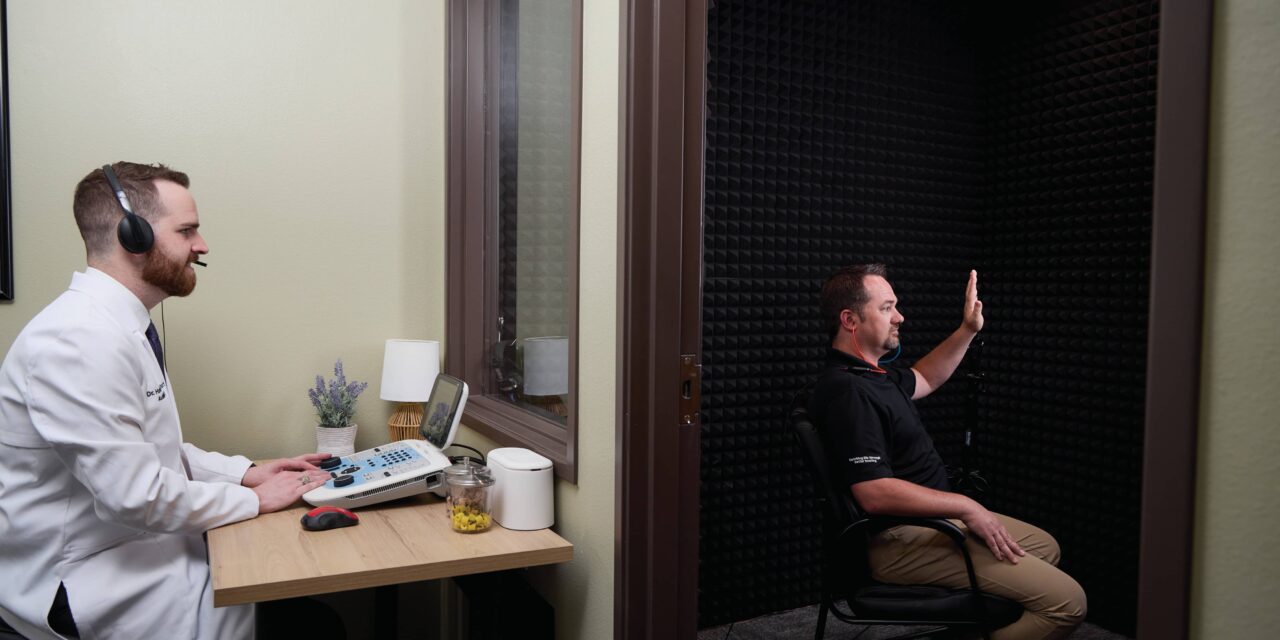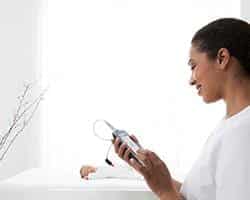Summary:
Modern audiometers are streamlining workflows, enhancing diagnostic accuracy, and improving patient counseling through integrated, automated, and upgradeable features.
Key Takeaways:
- Efficiency Through Automation: Features like auto scoring and integrated speech materials reduce manual workload, improve accuracy, and allow more time for patient interaction.
- Enhanced Integration: Audiometers that connect with other devices streamline data management and support advanced diagnostics in real time.
- Patient-Centered Counseling Tools: Built-in simulators and real-time data visualization help patients understand their hearing loss, leading to better engagement and treatment acceptance.
By Melanie Hamilton-Basich
Today’s audiometers are doing more than ever—saving clinicians time, improving accuracy, and even helping patients understand their hearing loss in real time.
“I work in a neurotology practice, so we need our audiometers to do a lot,” says Jessica Stiel, AuD, CCC-A, an audiologist at The Ohio State University Wexner Medical Center. “At the most basic level, an audiometer needs to be accurate, reliable, and easy to calibrate. Those are definitely essentials, but what I appreciate are the quality-of-life features that make testing more efficient for both me and the patient.”
And Stiel is not alone.
A two-channel audiometer that can be used for pure-tone air and bone conduction testing, speech tests, and masking will get the job done. But hearing care professionals have come to rely on the advanced features that allow them to accomplish these tasks and much more with increased precision and efficiency.
Auto Scoring
To start with, Stiel appreciates that many tests—including specialty tests such as ABLB, SISI, and tone decay—are built into today’s audiometers, and finds that automated scoring makes them all the more useful.
“Manual scoring, especially for something like QuickSIN or other speech-in-noise testing, can be pretty tedious and can be prone to error, so that’s definitely helpful when you’re in a busy clinic,” Stiel says. “Auto scoring not only improves accuracy but also allows more time to focus on counseling and interpretation instead of counting words. So that kind of efficiency definitely adds up when you’re working with a full schedule.”
She notes that automated scoring is not without its drawbacks, however. “I have a love-hate relationship with automation,” Stiel admits, “because you still need to be able to use your judgment clinically to know how to perform the test, but it makes things go faster.”
Speech Materials
Speech-in-noise testing is also an aspect of audiometry that is a differentiator for Hunter Gerhart, AuD ABAC, CCC-A, BC-HIS. “When I first started practicing, all of the audiometers were capable of all of the same essentials we expect for pure-tone air conduction, bone conduction, speech testing ….Except we were having to use a separate CD player or an iPod to play a lot of the speech materials on,” he remembers.
Now, the process of administering testing to patients is much more streamlined, as well as more advanced, which comes in handy for speech-in-noise testing. Gerhart, who serves as director of audiology at Livingston Hearing Aid Center based in Lubbock, Texas, says the philosophy at his practice is that all patients undergo speech-in-noise testing, to provide a more nuanced picture of a person’s hearing challenges.
“Our patients today are in complex listening environments with a lot of background noise. And so it’s important that we have the ability to identify how they are doing in these types of environments both with and without hearing aids so that we can make appropriate recommendations to help them improve their listening and comprehension in those situations,” Gerhart says.
“Having the ability to do all of that and not need to use extra devices [for speech materials] and to do aided sound field measures and unaided measures within the same device has also been really helpful and advantageous to our practice.”
Integration
Having so much integrated into an audiometer is extremely helpful, but the ability for it to “talk” to other devices is exponentially powerful. In the digital world we live in, utilizing systems that connect everything in a hearing clinic together is vitally important.
“Having features that support integration across systems, that’s always key for us,” says Stiel. “Directly linking to the electronic medical records is really helpful in allowing for testing modules like word recognition in noise, high frequency audiometry, or extended speech testing to really evaluate what we can offer clinically.”
She also values having the ability to view test results from different devices in one place.
“We have a pretty advanced tympanometry system that integrates with our audiometer so I can see it and it will transfer the results in with the audiometer for really, really specialized tests that some of our neurotologists request for, like a Patulous Eustachian tube if a patient’s eustachian tube is functioning properly or not,” Stiel says. “We can see that in real time. So to have that dashboard where multiple tests can go together is super helpful.”
Gerhart also greatly appreciates how much more efficient using an audiometer with an integrated system is. “We can transfer data from the audiometer right into our EMR and to the hearing aid programming database,” he says. “Prior to having that functionality, we were having to handwrite audiograms and then take that same information and input it into a system to be able to program the hearing aids.
“And now we’re able to do that exact same thing with just a touch of a button, which ultimately saves time for the hearing healthcare professional, but also saves the patient time as well.”
Upgrades Via Downloads
Another advancement in audiometry that’s had a major impact on the profession is the ability to upgrade current systems. Gerhart marvels at the fact that he has the option to use the Audible Contrast Threshold (ACT) test for his patients after downloading a software update for his audiometer—instead of needing to purchase a new system, as would have been the case in the past.
“As the landscape of audiology changes, as future tests become available to further strengthen our knowledge of how our patients are performing in these kind of real-world situations, I think that [ability] is super important,” Gerhart says. “I’m glad to see that most of the manufacturers have gotten on board with just releasing a software update that can increase the efficiency of the equipment that is already in place in our offices.”
The software update that will allow him to administer the ACT test isn’t free, but he would rather pay the fees for ongoing updates as needed than have to buy new hardware every time there’s an additional offering. To him, it’s more than worth it.
Counseling Tools
Some audiometry tech can more directly impact a patient’s understanding of their hearing health. Tools such as a master hearing aid and hearing loss simulation can help improve interaction with patients and make counseling more effective.
“I really like the built-in counseling tools,” says Stiel. “It’s great when we have the time to be able to simulate hearing loss or use real-time data visualization to help patients see how their hearing loss affects them in the real world.”
She often employs the hearing loss simulator tool to use overlays on a patient’s audiogram to show where they would hear birdsong or a jet taking off or certain speech sounds, but can’t because they’re out of the range of the frequency of sound they can hear.
“So it helps kind of take the circles and the X’s and put them into perspective and how it affects them in real life,” says Stiel.
This can often help people recognize just how much they would benefit from wearing hearing devices, and convince them to take action. “I definitely think it’s helpful to have that evidence where they can see right there, ‘OK, well, I guess I really am missing some of this information,’” she says.
A Noticeable Difference
Audiometer advances can stand out in more ways than one. While appearance is certainly not the most important consideration when it comes to audiometers, being able to use a device that looks sleek and even a bit futuristic doesn’t hurt.
“When I got a new audiometer in my office, my patients noticed that the machines are more modern looking and are smaller than what they used to look like a decade ago,” says Gerhart. He used that opportunity to educate his patients about the benefits of the new equipment, for him and for them. Because to him, that’s the biggest difference.
Compared to equipment she used in the past, Stiel says she’s impressed by all of the tasks that her practice’s audiometer helps her complete with less time and effort, and jokes that it probably has more features she could be taking advantage of, although there are others she wishes it offered. In fact, it’s a good idea to take stock of a clinic’s equipment at regular intervals to make sure it’s still meeting everyone’s needs, and to consider whether a newer model might be worth investing in.
It’s possible to live without the many technological advances that make today’s audiometers so much more efficient and easy to use. But especially if you’re in the market for an upgrade, why would you want to?
Featured image: Hunter Gerhart, AuD, using an advanced audiometer to conduct tests on a patient in a sound booth. Photo: Chris Duncan





